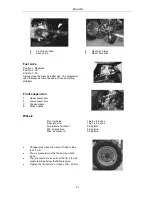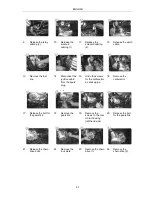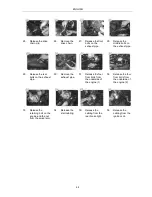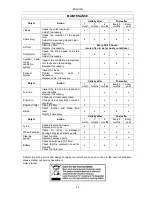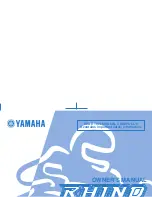
ENGLISH
51
ENGLI SH
SAFETY INSTRUCTIONS
Read the Operating Instructions carefully before use!
Larger machines (over 90 cc) should not be driven by persons under 16 to avoid exposing them and
others to safety risks. Make sure that the driver has understood all the instructions.
Remember that you are responsible for your own safety and the safety of others near you. 4wMoto
cannot be held liable for any accidents that occur, notwithstanding the reason. It is your responsibility to
inspect the vehicle for any faults and to drive safely.
The use of all motor vehicles always involves risk. By choosing to drive this vehicle you are accepting that
risk. 4wMoto cannot be held responsible for any negligence, speeding offences, component faults,
inexperience or any other conditions that could lead to serious or fatal injuries.
Carefully read through the following safety instructions. Remember that you are your own best protection.
SAFETY COMES FIRST
Pay attention to the safety information on the labels on the vehicle. Any labels that drop off or
become illegible must be replaced immediately.
Make sure you are familiar with how to use all the controls on the vehicle before driving it.
Beginners should always be supervised by experienced drivers until their driving skills have fully
developed.
This vehicle has been manufactured and designed for off-road use only. It is illegal and unsafe to
drive the vehicle on public roads, asphalt, pavements or cement.
Check which local rules and regulations are in force before driving the vehicle.
Also check which local environmental regulations are in force. We want to help keep our
environment clean, safe and beautiful for everyone to enjoy. We are sure that you do as well.
Driving an ATV is a responsible task. It can be dangerous. A collision or roll-over can happen
quickly and without warning, and often with serious consequences. Even routine manoeuvres such
as turning, driving over obstacles or on sloping ground, driving through water, mud or on other
loose surfaces must be done very carefully in comparison with driving other vehicles.
Never allow an
yone to ride as a passenger because this puts the vehicle’s road-holding
characteristics at risk.
Never drive on paved, asphalted or cemented surfaces.
Never exceed the recommended loading capacity. Spread the load evenly and secure it well. If you
are driving with a load, reduce your speed and remember that your braking distance will be longer,
especially if you are pulling a trailer. Overloading or unsuitable loads can lead to human error and
unnecessary danger, and you could lose control of the vehicle.
Keep both hands on the handlebars and both feet on the floor/pedals.
Never fit any unapproved accessories on to the vehicle.
Never try to perform stunts, jumps, two-wheeling or other tricks.
Never drive faster than your skill or the ground conditions permit.
Never drive the vehicle if you are ill, tired or under the influence of drugs or alcohol.
Inspect the vehicle before each use for mechanical faults or defective tyres, brakes or controls. The
vehicle must be in good working order with the necessary volumes of oil, fuel and brake fluid, and
correct tyre pressure.
Always follow the recommended procedures for inspection and maintenance.
Never use the vehicle in water courses or in water deeper than 12.5 cm.
Always use the recommended types of tyres and tyre pressures to reduce the risk of faults.
Always switch off the engine before refilling with fuel.
Never run the engine in closed spaces. This can have fatal consequences.
Always wear an approved safety helmet that fits well, safety glasses, gloves, long-sleeved jacket
and long trousers.

























